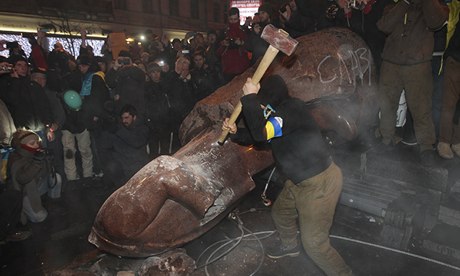It's interesting to read about the ongoing protest movement in Ukraine and then examine the lack of coverage in the United States. Throughout the 2000s, color revolutions were widely praised and reported on. They were viewed as clear indicators that democratic progress could not be halted and was organic to populations throughout the world. However, the 2010s brought out the Arab Spring, which has led to a more convoluted environment in the Middle East than anyone can truly outline. Moreover, those color revolutions, in many senses, only half-panned out - democracy, where it was itching to flourish, has stagnated.
In case you were wondering, this is going on in Ukraine:
(source: Sergei Chuzavkov/AP via Guardian)
What is that, you may be asking? Those are opposition protesters toppling and destroying a statue of Lenin that has stood since 1946, a la the famous toppling of the statue of Saddam Hussein (more photos via the previous link). Shortly thereafter, a European Union (EU) flag was raised where the statue had stood. These protesters are not yet at "revolution status," but they sure are making a point.
That point is that Ukraine is a deeply divided country, politically, linguistically, and, to an extent, culturally, though outsiders often ignore this. Though Ukraine is one nation-state, it is surprisingly evenly cut in half between East and West.
One part of Ukraine wishes to align itself with Russia, which is gradually building up its own outsider-EU political superstructure via the Collective Security Treaty Organization (CSTO) and the more recent Customs Union of Belarus, Kazakhstan, and Russia. Both historically, and in present day, Russia has wielded extraordinary influence over landlocked regions of Eurasia. Russia has served as an outlet to both West and East, and as a protector of limited sovereignty to those who follow it.
Meanwhile, the other part of Ukraine wants to continue its ongoing, lengthy process with the European Union. Eventually, this groups wishes to break free from Russia's grasp and join the European Union outright. This would greatly extend the borders of the European Union and the extent that those borders parallel Russia's.
And that's where the trouble started. Ukraine's president, Viktor Yanukovych, who has kept his opponent from the previous election Yulia Tymoshenko languishing in jail on largely dubious grounds, and his government elected to halt discussions with the EU and instead lean toward Russia. Part of the wedge is the jailing of Tymoshenko, which Western nations feel is unjust and illegal. The rest is a nation still feeling its way out of the shadows of the USSR, all these years later.
Perhaps this won't be a color revolution, but a real revolution, unlike those seen since the 1990s. 100,000 protesters can't be a quiet voice. Then again, this could all the same tear the country in half, an effect that has been brewing for decades.

No comments:
Post a Comment